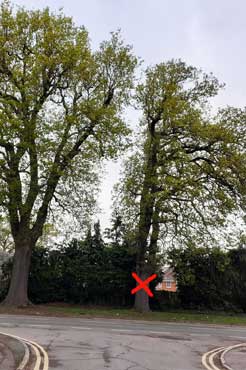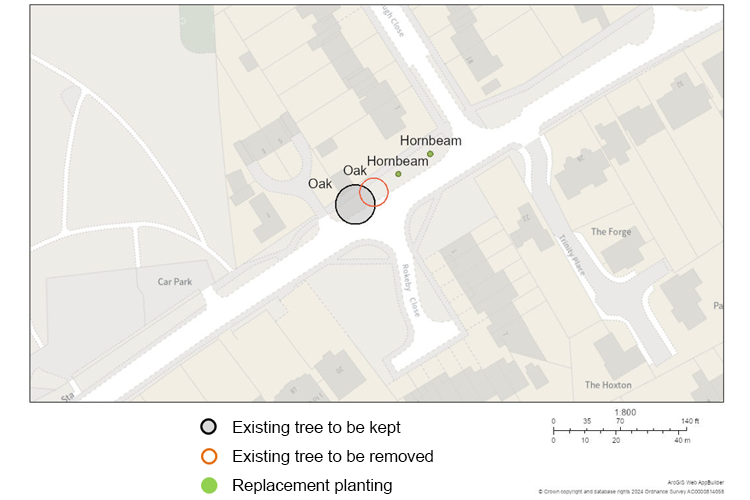
Consultation reference: 002
Start date: Thursday 30 May 2024
End date: Thursday 27 June 2024
Location: Park Road, Bracknell
Number of trees: 1
Tree species: oak
Reason for removal
This tree is the cause or a significant contributing factor in subsidence damage to 1 Ellenborough Close. This constitutes a legal nuisance. Unless appropriate action is taken, the council will be liable to pay damages that far exceed the value of the tree.
We have considered other solutions, including:
- pruning
- root barriers
- underpinning
However, on balance, these solutions are not reasonably practical or affordable in this case.
Proposed replacement planting
Our proposed replacement trees include 2 hornbeams on the roadside grass verge, south of 1 Ellenborough Close.
We carefully chose the species and locations. They were chosen to give the most benefit and to avoid more damage to nearby buildings.
Hornbeam is a low water demanding species with a zone of influence of 8.5m. They will be planted 12m away from 1 Ellenborough Close's building. This placement means they won't cause damage in the future.

Consultation feedback
Number of respondents: 3
Where they heard about the consultation: 3 saw the tree notice
Tree removal proposal: 3 disagree
Replanting proposal: 2 disagree, 1 no comment
Resident feedback
Tree is long established and removing it will dramatically change the aesthetics of the street.
Our response
There is no doubt that this tree is a good size and that it provides public amenity for local residents. It’s proposed removal is regrettable.
It is the smaller of 2 mature oaks in this location. The larger, more dominant tree, is being kept.
Resident feedback
The oak tree is a haven for local wildlife.
Our response
Oak trees are important habitats for wildlife, particularly when they are mature. In the case of the subject tree, it is not ancient or veteran.
We will take all reasonable measures to make sure that no protected wildlife will be killed or injured as a result of its removal.
We are replanting with native hornbeams. The Tree Council says:
Hornbeams are valuable to wildlife, producing nutlets which are eaten by hawfinches and small mammals. Over 50 species of invertebrates have been found feeding on this tree.
Resident feedback
Tree stores carbon, helping to fight climate change.
Our response
We recognise that climate change requires urgent action from us all. We have committed to being carbon neutral by as close to 2030 as possible.
According to Forestry England:
More carbon is stored in the centre of the tree where it is locked away until the tree dies or is cut down. If the tree is harvested for timber then the carbon stays locked up in the wood. If the wood is burned, or if the tree is left to rot then the carbon is slowly released back into the atmosphere.
Our ranger team will be using the trunk of this tree to make benches for the local parks.
The brushwood will be chipped and used to mulch newly planted trees around the borough.
For more information about our commitment to being carbon neutral, visit our climate change pages.
Resident feedback
Tree provides shade when it is hot and gives shelter from rain.
Our response
The vast majority of the shade cast from the tree is in the back garden of 1 Ellenborough Close, whose property is being damaged by the action of its roots.
There is no bus stop, bench or other obvious reason for pedestrians to stop under the tree, so the loss of shelter from rain is not a significant issue.
The larger more dominant oak tree, which is being kept, will continue to perform these functions. The replacement hornbeams will also contribute in the future.
Resident feedback
Lack of detail in the proposal about the damage the tree has caused to the house.
Our response
The property sits on a medium shrinkage clay soil that has been shown to be desiccated (dehydrated) below the area of damage (rear of the property). Oak roots were found under the area of damage. Crack and level monitoring demonstrate seasonal movement.
The technical evidence has been reviewed by:
- the claimant's specialists
- the council’s arboricultural specialist
- an independent consultant
It is deemed to reasonably demonstrate, on the balance of probabilities, that this oak tree is the cause or a significant contributing factor in subsidence damage to 1 Ellenborough Close.
Resident feedback
Query about the impact of the tree on main body of the house, when it is over 20 metres away.
Our response
English oaks are a high water demanding species with a zone of influence of 25m. The subject tree is approximately 15.5m away from the area of damage.
Resident feedback
Query about the impact on the tree of a dry year and building work by homeowner.
Our response
The clay soils on which the property is built and the impact from the exceptionally hot and dry summer of 2022, were contributing factors to the subsidence in this case.
We can’t comment on the specifics of modifications made to the property by the householder. Only that any building work by the landowner would be subject to building regulations.
Resident feedback
Asks if bench footing has been investigated.
Our response
It has been considered that, on balance, the best solution in this case is for the council to remove the tree. This is instead of paying for much more expensive engineering solutions like underpinning or benching. We need to prioritise available resources to conserving and enhancing council managed trees where it is safe and practical for us to do so.
Installing a root barrier is also not practical. The excavation would likely damage the trees' roots.
Resident feedback
Concerned this would set a precedent for similar claims.
Our response
Subsidence claims caused by council managed trees are not common.
A combination of factors led to this subsidence claim, including the:
- hot and dry summer in 2022
- underlying clay soils
- proximity of the oak tree to the property
Claims will be managed on a case-by-case basis. Every consideration will be given to preserving the trees where it is safe and practical to do so.
Resident feedback
Concerned there might be similar complaints about the new trees when they are older.
Our response
Hornbeam is a low water demanding species with a zone of influence of 8.5m. The new trees will be planted at a minimum of 12m from the building at 1 Ellenborough Close. They are highly unlikely to cause damage in the future.
Resident feedback
Proposed new trees are a poor substitute for an ‘ancient oak'.
Our response
The oak tree proposed for removal is not considered to be ancient or veteran. The subject tree is estimated to be about 90 years old. The larger more dominant one, that is being kept, is about 125 years old.
The Ancient Tree Forum definition:
Ancient trees are those which have reached a great age in comparison with others of the same species. The exact age at which you’d call a tree ancient depends on the species of tree. An oak tree would not be thought of as ancient until it’s at least 400 years old. Characteristics of an ancient tree depend on the species, and on factors such as the site and conditions under which they have grown.
However, they have 3 key features:
- a low, fat and squat shape – because the crown has retrenched (reduced in size) through age
- a wide trunk compared with others of the same species
- hollowing of the trunk (not always visible)
Unlike an ancient tree, a veteran tree can be any age, but it is a tree which shows ancient characteristics such as those above. These may not just be due to age, but could result from natural damage, management, or the tree’s environment. Ancient trees are all veterans, but not all veterans are ancient.
In time, the replacement trees will provide local value for wildlife. See feedback under comment 2.
Decision outcome
To proceed with the proposed work outlined above.
Removal to begin no earlier than 15 August 2024.